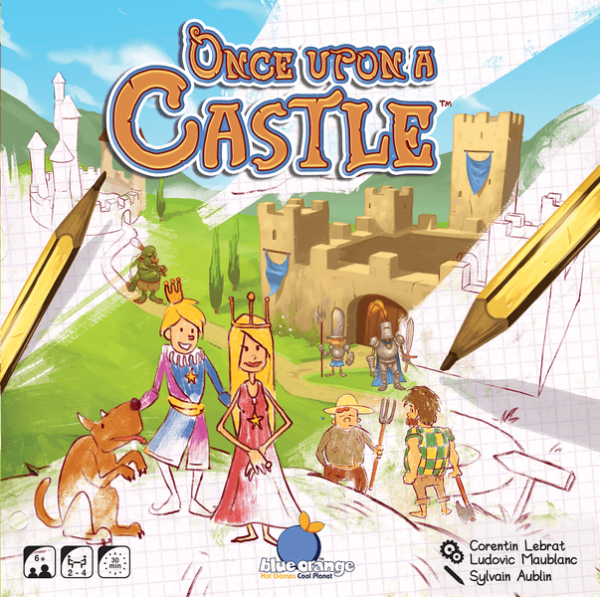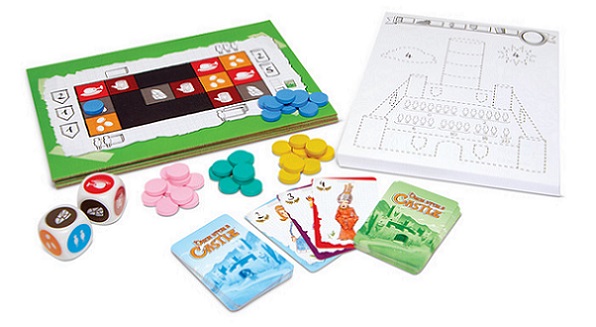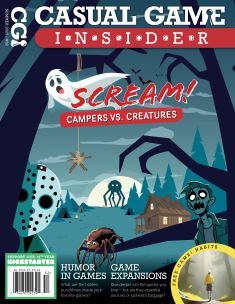Draw a Castle and Invite Guests and Residents in Once Upon a Castle

Build towers and castle walls, invite guests from throughout the kingdom, and fill your fortress with residents.
Published by Blue Orange Games, Once Upon a Castle is a roll-and-write (or roll-and-draw) game, in which players are competing to build their castles the fastest while also making sure each piece scores them the most points possible.
Gameplay
Each player takes a resource board and ten colored tokens. Each player also takes a sheet from the castle pad. The sheets have two sides, one of which already has a castle drawn in and you just fill out the lines, and one is blank so players can draw the castle for themselves.
There are two modes of gameplay: apprentice and grand architect. Both play very similarly, though you use different sides of the resource boards depending on which mode you play. Both also come with different guest decks. For apprentice, you simply shuffle the guest deck and place it in the middle of the table. For grand architect you shuffle the deck and then draw three guest cards and place them face-up to form the display.
On your turn you roll the two dice. The results on each die will either be two residents, one of the four resources, or a question mark, which allows you to choose any possible die result. On your turn you get the reward from both dice. If it is the residents, you fill in two residents on your castle sheet. For each resource, you place a token on a matching resource space on your resource board. Each resource appears three times on these boards. You may not move a token once it has already been placed. Every player who is not the active player may select one of the two dice results to activate for themselves.
At the end of your turn, if any row or column on your resource board is completely filled, you may remove the tokens in that row or column and receive the reward associated with that line (as long as they did not cross each other, you can in fact activate multiple rows or columns at the end of your turn). The rewards include building a wall for your castle — you can build a total of four walls. There are also multiple rows and columns that allow you build walls, some of which will also earn you additional residents.
Another possible reward is to build a tower — you can build a maximum of four towers. A tower is worth a set number of points depending on which row or column you used to build it. The first player to build all four towers can draw a sun on his sheet, which is worth four points. You can also build flags. You can only build up to six flags and only on completed walls. Flags are the same as towers in that they are worth a number of points based on the row or column used to build them.
Finally, you can build one of your donjon’s floors. There are four floors in total. In apprentice mode, when you draw a floor you also draw a guest card from the deck, which is worth the number of points printed on it. In grand architect mode, you select one of the guests from the display (another is immediately drawn from the deck to replace it).
In grand architect mode, while each guest is still worth a number of points, some have special abilities, such as gaining you extra resources or basing its point value on pieces of your castle you have built at the end of the game. Some guests have a lightning icon, which means their ability activates when you gain them. The resource board in grand architect mode also has a row which, when completed and activated, allows you to trigger all your guests with a lighting ability again. Another column allows you to steal a guest from another player.
The game ends once someone completes the twelfth and final part of her castle. This player gets to draw in a cloud on her sheet which is worth four points. Players then add up all their points, with residents being worth a number of points based on how many you drew in during the game. The player with the most points wins the game.

Review
Once Upon a Castle is a simple, family-friendly roll-and-write game. Its rules are not complicated, and the apprentice mode offers simple scoring, while the grand architect is a good fit for people who want slightly more complex choices. This makes the game more versatile.
How you place your tokens on your resource board seems simple at first but as the game goes on you begin to appreciate the strategy of which columns or rows you go for and what pieces of your castle you complete when.
We liked the double-sided castle sheets, and it’s a fun option to be able to fill in your castle yourself, while you can easily use the pre-drawn side to remind you exactly how many pieces of each building you can make. The resident figures can also be fun to draw in if you’re feeling creative. All of which helps to make this a good fit for families.
The rulebook could be a little clearer, and examples of gameplay would have been useful. The components are nice, with big chunky dice, plenty of castle sheets and a fun style for the artwork.
Once Upon A Castle has a nice aesthetic, looking almost like child’s artwork (though still a child who draws quite nicely). Given that, it is a little odd that one of the guests at the castle is a courtesan, but this is likely a translation issue when the French edition of this game was translated into English — 'courtier' is probably what was intended.
There are a lot of roll-and-write games on the market, but Once A Upon A Castle is worth giving a chance to. Its theme is whimsical, it is adaptable for your gaming group, it is a nicely put together game, and is an especially good fit for families.
Pros: Component quality, two modes, great fit for families
Cons: Rulebook could use some improvements, minor translation issue
Disclosure: we received a complimentary review copy of this game.







